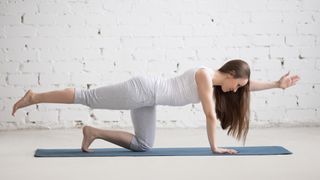How to improve hip mobility
Looking to improve hip mobility? A physiotherapist reveals exactly how

Knowing how to improve hip mobility is not just important for professional athletes or regular exercisers but for carrying out daily activities such as walking up and down stairs and bending down to play with your kids. Having tight hips can hinder overall mobility in the body as well as fitness performance and contribute to lower back pain.
Thankfully, there are certain activities and stretches we can do to increase mobility within the hips, whether it’s stretching out on the best yoga mat or doing weighted squats. Here we speak to chartered physiotherapist and clinical director of Complete Pilates Helen O’Leary who reveals what causes limited hip mobility. She also discusses her top moves for combating this, and explains why continuing to work on your hip mobility is crucial.
Always check with your doctor before making any changes to your lifestyle and/or beginning a new exercise regime.
What causes limited hip mobility?
O’Leary explains that a decrease in hip mobility is a natural part of getting older. But a common cause can be due to a person’s anatomy, she adds. “Some people are just not designed to be as flexible. Your hip sockets are shaped quite deeply and some people don't have that innate mobility around the [hip] joint because they're built stiffer. If you couldn't touch your toes when you were eight-years-old, for instance, it's not uncommon for you to never be able to touch your toes. And, that’s okay.”

Helen O’Leary is a chartered physiotherapist and Pilates instructor/director of Complete Pilatesin London, England. She graduated from Birmingham University in the U.K. in 2008 and completed a Polestar Pilates Rehabilitation course in 2010. After 13 years of dealing with acute trauma injuries as a physiotherapist, O'Leary works with clients before and immediately after surgery to optimize their recovery.
Injuries or only doing a specific type of training can also result in limited hip mobility. “If you do loads of high-intensity interval (HIIT) training, your body becomes very habitually dominated towards that activity. You can gain lots of power, but you won't necessarily have the mobility,” O’Leary says.

How to improve hip mobility
Doing movements involving rotations is a great way to increase hip mobility, O’Leary explains. “This is because your hip is a ball and socket joint, so it never moves in a straight line, [unlike] your knee, which is a hinge joint that moves straight. Whereas every time your hip moves, it rotates, it rolls, it slides, it glides.”
Adding some weight to compound movements, such as squats, lunges, step ups, and deeper step ups, can also help, claims O’Leary. “If you build strength and start to challenge your range with those movements, you'll start to [increase your] flexibility.”
- Related: What is PNF stretching?
She suggests pairing this with Equipment Pilates because your muscles contract eccentrically (they get longer) as you move against the springs. This is why everyone feels taller after Equipment Pilates, she explains. In turn, this helps with flexibility and range of movement in the hip joint. A study in the Age journal supports this. After 20 elderly people followed a 10-week Pilates training program, there was an observed increase in flexibility in hip flexion, with this type of training being shown to improve the functionality of elderly individuals.
Walking regularly is also important for hip mobility, particularly if you’re walking up or downhill, says O’Leary. When you walk uphill, you have to lean forward more and you may have to walk up and down steps. This keeps the fluid moving around your hip and helps with the ease of carrying out everyday activities, she explains.
Exercises to improve hip mobility
O’Leary shares her top three movements for improving hip mobility.

Side-to-side on box
O’Leary says the flexion in this exercise changes the angle of your hips which, along with the added rotation provides more freedom [in the hip joint]. It is a particularly great post-hip replacement move, she adds.
- Lie on your back with your knees bent at roughly 90 degrees above the floor, stacked inline with your hips, and your feet resting on your sofa or an exercise block. Make sure your feet are wider apart than your hips.
- Let your knees roll over to one side, then bring them back to center and roll them over to the other side. When you do this movement, imagine you're pulling the top leg down to the bottom leg and reaching it forward over the lower knee; this will stretch your quad as well, explains O’Leary.
Tip: To make this easier, you can do this with your feet flat on the floor.
Reverse nordic curl
This exercise primarily works the hip flexors and eccentrically works the quads; this means that your quads lengthen while you're loading them, says O’Leary, so they will get stronger as they get longer. This will reduce feelings of stiffness when in hip flexion.
- Begin upright in a high kneeling position. Ensure your knees are on something soft, such as an exercise mat, to protect them.
- Press the front of your shins and feet into the ground. Keeping your spine and neck long, begin to hinge backward.
- Then, continuing to press into your shins and feet, gradually rise back up again. You should move slower on the way down and slightly quicker on the way up, says O’Leary.
Romanian deadlift
- Stand up with your feet flat on the floor, spaced slightly narrower than your hips. Place your hands on the front of your thighs then, imagining there is a wall behind you, stick your bottom back towards the wall as your hands slide down the front of your thighs. You're trying to create a static, flat back. The most important thing is that your bottom goes backward as your chest hinges forward, says O’Leary.
- Next, simply rise upwards and forwards.
Why is it important to work on your hip mobility?
Continuing to work on your hip mobility is vital for daily life and supporting you as you age. When you reach your 60s or 70s, you might have grandkids and want to play with them, says O’Leary, and having good hip mobility means you can get down to the floor. She explains good hip mobility is also beneficial if you fall because you need to be able to get back up. You need a degree of mobility to achieve this. If you don't have that, you’re at risk of being injured.
O’Leary adds: “It’s one of the most functional things we can do that keeps the enjoyment in our lives. It means you can sit on a sofa and not worry if it's too deep, you can go out for dinner and sit in a chair no matter how high it is, you can continue to walk down the road with ease, you can get on the floor and play with your children, and you can load the dishwasher. It just makes life easier.”
Sign up for the Live Science daily newsletter now
Get the world’s most fascinating discoveries delivered straight to your inbox.
Gemma Harris is a UK-based freelance journalist and health writer who blogs at thegutchoice.com. She produces content for multimedia health and lifestyle platforms, including calmmoment.com, StomaTips, Planet Mindful and metro.co.uk because she has a passion for health and wellness. When not writing, she can be found walking or running in nature, at a yoga or spin class, swimming or having cocktails with friends.

